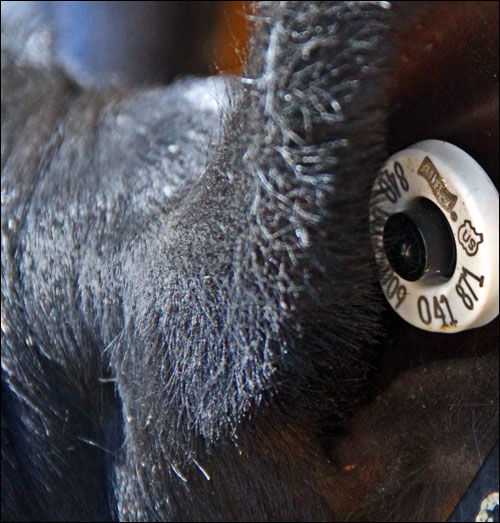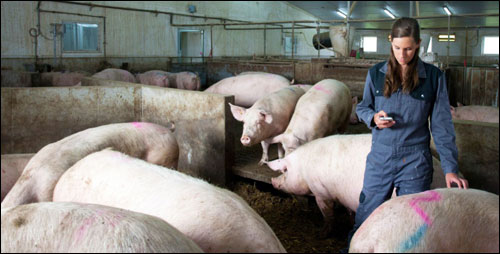Jun 17, 2013In the United States, cattle tend to be bought and sold more often than most other livestock, so when there's an outbreak of bovine tuberculosis or bovine spongiform encephalopathy (mad cow disease), it's difficult to identify the point of origin and other potentially diseased animals. The U.S. Department of Agriculture (USDA) had been administering the National Animal Identification System, a voluntary livestock-tracking program, but the program suffered from a lack of participation and was eventually discontinued.
Some ranchers preferred not to share information about their business with the government, and many small farmers said the cost was prohibitive. The program recommended but did not require the use of radio frequency identification ear tags, which have been demonstrated to be more effective than plastic ear tags or bar codes that tend to get covered in mud and become difficult to read.
But when cattle can't be traced accurately to specific locations, herd testing often is expanded to determine any possible exposure to disease. The USDA cites that bovine TB investigations frequently exceed 150 days. "Tracebacks today might take us several months to complete because of a lack of information," says Neil Hammerschmidt, USDA program coordinator for animal disease traceability.
That situation is about to change. This year, the USDA published its rule for animal disease traceability, to make it easier to track and trace livestock. Addressing farmers' concerns, the rule applies only to livestock moved interstate and offers a choice of official identification: Producers can use low-cost National Uniform Eartagging System metal ear tags, or RFID tags—low-frequency (conforming to the ISO 11784/85 standard), high-frequency or ultrahigh-frequency—from authorized manufacturers.
"When there is the potential for disease in the future, this means we will have the ability to better respond to it," Hammerschmidt says. The USDA expects a high level of compliance with the rule during the next few months. Whereas Australia, Canada and Uruguay have mandated the use of RFID for cattle tracking, the USDA is allowing the industry and states to decide which approach they will adopt.
(Argentina and Brazil are among the countries that also offer RFID as an option for identifying cattle.) "It's important we make it very clear that RFID is not a regulatory requirement for this program," Hammerschmidt says. "The states get to implement it as they like," and other states cannot require RFID ear tags be used for cattle moving into their jurisdictions.
"As we mature into this plan, a high percentage of animals will have an official identification, so the time intervals that were weeks or months can come down to a matter of days or weeks," Hammerschmidt says. "The shorter you can make it, the less chance the disease will spread, which is a value for the producers." And, reducing the number of herds that would require testing because of increased precision about the origin of an infected animal is certainly more economical.
Michigan cattle ranchers can attest to the benefits of RFID. In 2000, the state lost its USDA-granted bovine tuberculosis-free status. Today, all except 11 counties have regained the designation, thanks to a 2007 mandate to use LF RFID technology to improve animal traceability for controlling and eradicating the disease. (The 11 counties have a problem with infected deer herd, which transmit the disease to cattle.)
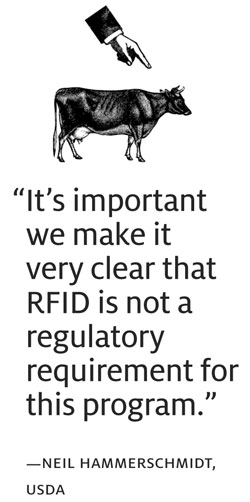
Since the state began requiring the use of RFID tags on cattle prior to the animals leaving the premises—being moved to another farm, the livestock market or slaughter—as well as for testing in its TB zones, cattle producers have purchased approximately 3.5 million RFID tags, says James Averill, director of Michigan's Department of Agriculture and Rural Development's Animal Industry Division. The 15-numeric-character tag identifies a single animal for its lifetime both, electronically and in print. Cattle producers have to provide their premises number when they order tags; that information is recorded in the state's database, along with records of which cattle have been moved within or from TB zones and where, their TB tests and slaughters.
RFID has helped the state accomplish bovine TB testing much more efficiently than the old means, which involved trying to grab hold of the animal's head to read a printed metal tag and possibly having to scrape mud off the tag, on the day of the tuberculin injection and again three days later to check the site for a response. "With RFID, it's just using a handheld wand" to read the animal ID, which is then correlated with the test results, Averill says.
In addition, RFID has helped improve the image of Michigan ranchers. "Wisconsin, at one point, required TB testing pre- and post-entry for cattle entering the state, so it was nearly impossible for our cattle industry to sell there," Averill says. "RFID opened that window up," with Wisconsin reducing the requirements for moving cattle there because of the strides Michigan has made at home with testing and traceability.
Tracking and tracing cattle, as well as deer, pigs and sheep, for disease management and prevention is a key driver of RFID in the livestock industry. But without government encouragement or mandates, many farmers still choose other methods to monitor their herds. They are more likely to adopt RFID only if they can achieve other business benefits from its use. Gaining greater value, however, may involve a switch to ultrahigh-frequency from the predominant LF technology, says Michael Liard, VP of auto-ID at VDC Research. Meanwhile, innovative RFID solutions are helping to keep animals healthy while they're on the farm.
From Farm to Fork
RFID-tagging can deliver economic and operational benefits to the livestock industry if it provides "more of a picture of supply-chain visibility through animal identification—not just, 'Here's when it was born and some limited information about it,' but really embrace the concept they use in the marketplace of farm to fork traceability," Liard says. "We have to extend the value proposition further down the supply chain and tie it to the message of visibility plus safety and security."
Potential economic benefits stem from "getting a better handle on the history of the animals and being able to do data mining, to tie together and understand how all the information fits together," says Dale Blasi, a professor at Kansas State University who oversees research at the KSU Beef Stocker Unit. In addition, he says, the industry can gain some economic value by exploiting opportunities to provide assurances about the origin of beef and other meat products.
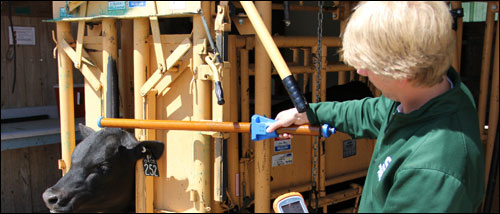
Nortura, a cooperative of some 30,000 farms, is Norway's largest meat producer. In 2006, it began an RFID initiative aimed at using the technology to improve efficiencies in all its production and logistics processes. The organization's ultimate goal is to enable retailers to use product information, such as the region animals are from and what they ate, for marketing and advertising, and to let consumers check product details by scanning tagged packaging in stores with their mobile phones.
In Pennsylvania, the nonprofit Center for Beef Excellence, in cooperation with the state's Department of Agriculture, is spearheading a voluntary RFID animal ID program for the producers of its 455,000 beef cattle. The program helps producers with herd management and traceback, but aims to do more, says Ann Nogan, the center's executive VP. "It's designed to address the consumers' concerns about where their beef is coming from," she says, "and it equips the producers with the ability to confidently say they are addressing those concerns."
In January, the program began providing free LF tags from Allflex to producers who provide their premises identification. The tags are nonremovable and nontransferable from the animal to which they are attached, and owners must agree to keep records of each tagged animal for a minimum of five years. The center maintains the serial numbers of tags it delivers to each producer, each tied to related information about the animal and farm.
"The paperwork can establish a paper trail for them to show the cattle were locally sourced," Nogan says. So, at on-farm retail markets or conventional farm markets, producers have the data that allow them to reliably tell consumers that the beef is locally sourced. It's a verbal confirmation, and it's not a method that would work at grocery stores and supermarkets, but it's a start, she says. "I do think the local concern to have local products in general is being driven by consumers, as they become more educated," she adds. "They want to know what they are getting and they seek to have that local product.… There are a lot of unknowns with some foods from the global product supply line, and we are fortunate to be able to say we provide one of the safest, most quality beef products possible."
The RFID-enabled farm-to-fork traceability idea is valuable from the public health and food safety standpoint, says Michigan's Averill, though it is challenged in that "when it comes to buying practices in supermarkets, consumers are not yet willing to pay extra per pound for traceability of products such as hamburger." But, he adds, "they are slowly coming around, especially in local markets where consumers want to know where the product comes from."
Beyond Traceability
In 2010, a European project called Farm to Fork was launched to determine how RFID—in particular, UHF technology—can help the perishable-goods supply chain. One participant is Buttercross Farm Foods, a pork producer and retailer in Market Drayton, England, which is tracking meat through processing and, eventually, to its stores.
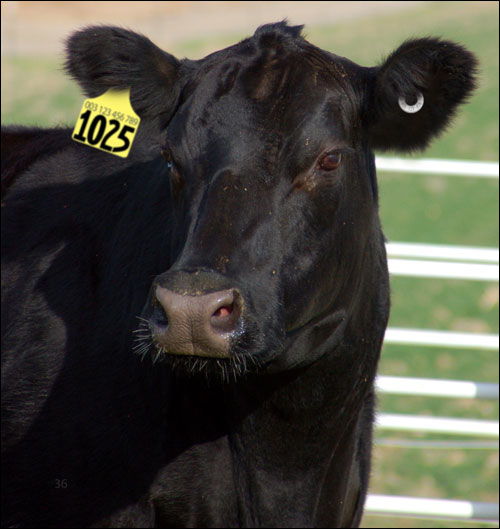
Indeed, just as many governments are working to encourage livestock producers to use LF tags to monitor their herds, there is growing interest in moving to passive UHF technology. "UHF RFID has a longer read range and is a bit less expensive than LF," Liard says. In addition, he says, "The EPC standards are in place not just for the communication of information, but for the sharing of information, particularly if you think of the supply chain and global visibility." But, he notes, it's an education hurdle to migrate to UHF because there's a core understanding of LF technology.
New Zealand's National Animal Identification and Tracing (NAIT) project recently mandated that cattle and deer producers identify their herds with LF tags. But the country's nonprofit Pathfinder Group has been urging the adoption of EPC technology for several years now. "Fundamentally, exports—food and meat products from New Zealand—are part of our backbone," says Gary Hartley, the organization's secretary. "UHF does perform in livestock and meat traceability apps, both at the hardware and data levels. We can use global identifiers for not only live animals, but cartons of finished meat cuts to provide very robust traceability at locations along a supply chain." For product recalls, he says, the industry needs traceability systems that provide for the extended supply chain from start to finish; "otherwise, it's just too hard."
The NAIT system, in fact, makes a provision for UHF-related data fields as primary identifiers, Hartley notes, so moving in that direction doesn't require complete systems refitting. The Pathfinder Group recently published a report on the use of EPC RFID standards for livestock and meat traceability, discussing a project it ran in which UHF ear tags were placed on deer at a New Zealand farm so the animals could be tracked through to the point their meat was delivered as venison cuts to two retailers in Hamburg, Germany. "When they were moved off the farm, onto the truck, in the process we read all the tags of the deer that were precoded with EPC unique identifiers," Hartley says, noting that those readings were date- and time-stamped.
Of course, other tags had to replace the ear tags on the deer because, as Hartley puts it, a deer at some point ceases to be a deer. But, there is always a parent-child relationship between the unique RFID number at the next stage of the process and the one at the preceding stage. "From the whole deer to the carton of finished venison cuts, we were able to create a parent-child relationship starting with the original numbers that were on tags in the animals' ears," he says.
Every time a significant event happens, "going from the boning room where the animal is chopped up, to being put into boxes, to the chiller room, to the shipping container, to being transported overseas to Hamburg, with doors opening and cartons being taken out, we read the unique ID on the cartons," he says. "The way the EPC standards are written, we can understand things like what it is, where it's happening, what's happening, what's the business process that's happening, and what is the next scheduled step in the process, so we have traceability and audit."
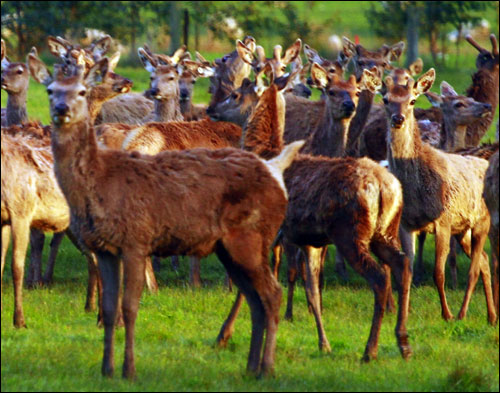
Data from the RFID tags is the real key, of course, and leveraging the GS1 global data standard throughout the journey from live farm animal to cartons of finished meat at a retailer "just makes more sense to us than using different IDs at different stages of the supply chain," Hartley says. "To us, that creates inefficiency and potential risk around redundancy of data. So on the one hand it is about UHF versus LF regarding which form of RFID is more fit-for-purpose at different parts of the supply chain, but the key to all this in our view is the data story."
In Scotland, efforts are under way to pursue the use of UHF tags for cattle identification. "Many farmers would like to carry more information on the tag than is available with low frequency, and that takes us to UHF," says Bob Yuill, deputy chief executive of the Scottish Agricultural Organisation Society and manager of the ScotEID database system for animal traceability. "It reads at distances up to 7 yards, the antennas are directional, and it reads groups of animals with no problems with collision." Tags must be able to handle more information because every Scottish bovine already has a unique identification number registered on the U.K. government cattle database, and the structure of that ID cannot fit into the ISO 11784 LF standard, according to Hamish Stuart, technical advisor on the ScotEID project.
The ScotEID system was used originally to track only sheep, which are identified with LF tags, but it was created with the intent that it ultimately would track all livestock. The ScotEID project recently received $1.5 million in government funding. "We now have a data system that is tracing sheep using LF technology, and have to find the best technology for cattle, and that is why we are investigating UHF," Stuart says. The thought is to tag cattle with UHF technology to track its movements, recording them in the database as part of a broader plan to eradicate bovine viral diarrhea in Scotland. "It's 14 to 20 days behind by the time you track everything in paper," Yuill says. "When you use automated systems, like we already use for sheep with RFID, it's basically real time."
Some Scottish cattle farmers are using LF tags for management purposes, and some dairies are using the technology to trigger feed systems. In a significant year-long field trial of RFID to track cattle from birth to slaughter just announced by the Scottish government, both UHF and hybrid LF/UHF tags will be in the mix.
In Denmark, most cattle are fitted with LF tags, as required by federal mandate, and while farmers are not required to track their pigs electronically, many have also tried LF tags to improve their visibility into each pig's whereabouts, and to provide an automated record of every animal's history, its travels to electronic feeding stations, and medical treatments or vaccinations. The Danish Agriculture & Food Council's Pig Research Center recently completed a PigTracker project, to determine whether UHF tags, which have a longer read range and make it easier to track animals that move quickly in multiple directions, are a viable alternative.
Since the project concluded, more farms have begun to use UHF technology. "Working with smaller pigs, it's like sheep, like working with flocks—these pigs go into this truck or were moved from A to B or were vaccinated," says Niels Peter Baadsgaard, a veterinarian serving as the center's chief scientist for veterinary research and development. "That's the nice thing about UHF. You can adjust the energy to cope with both individual readings and group readings."
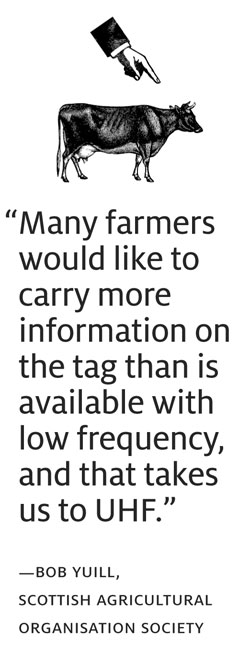
Despite some tough economic times for those in the livestock industry that make the proposition of investing in new materials and systems difficult, KSU's Blasi says there is an uptick in activity in the use of both LF and UHF RFID technology. "With the advent of the animal disease traceability program, many producers and veterinarians are recognizing that visual ID tags are too cumbersome, slow and prone to error, and people are just going to say it's just not time-efficient to do that," he says. Whether UHF overtakes LF in livestock applications remains to be seen, he says, but the potential is there. "Some of the attributes of the higher frequency, some of the things that can be done with it—the read range, the ability to link up on the Internet and utilize data management—it's not only for identification but can provide a comprehensive package of offerings."
Liard believes that passive UHF RFID would likely afford a lower total cost of ownership and faster return on investment than conventional LF technology for animal identification. The data collected and shared via UHF technology could deliver benefits beyond traceability, he says, including improved product recall management, quality assurance and access to new markets through certification programs.
The Care and Feeding of Farm Animals
In Europe, dairy cattle and breeding sows must be allowed to reside in groups and move around freely within them, in oversize barns or sheds, rather than being confined to a single space. Those groups can get pretty big: It's not uncommon for 500 sows to band together. This means it can be a tricky to see if an animal is lame or has stopped eating, or to locate one that needs medication.
Farmers in Austria and Germany are monitoring cows and sows with an RFID-based real-time location system (RTLS) from MKW electronics. The system, which includes ear tags, are designed to help them stay aware of their animals' activities. The tags are also suitable for sheep and goats. "With our active RFID RTLS system and pattern recognition, we have sensor technology to give to the farmer an indication if an animal is ill or in heat," says company founder Wolfgang Auer. "Without RFID and RTLS, the farmer and his employees have to physically look at the animals, which takes a lot of time."
CowView, from GEA Farm Technologies, also is designed to monitor animal behavior. The solution uses ultrawide-band RFID tags and readers to detect when a cow is in heat, moving around or lying down, and it alerts farm management when it detects changes in typical patterns, which could be early indicators of an illness.
GreenFeed, from C-Lock, is designed to prevent bloat in ruminant animals, a category that includes cows, deer and buffalo. These animals have an extra stomach, or rumen, which acts as a holding vat for feed until its regurgitated and rechewed. But carbon dioxide and methane build up in the cow's digestive system during the rumen process. "The way cattle release gas generated in rumen is through belching," says Scott Zimmerman, director of engineering at C-Lock.
GreenFeed measures gas emissions, so farmers can identify which cows need to have their diets adjusted for greater feed efficiency. When a cow with a low-frequency ear tag visits a feeding station, typically several times daily, a reader identifies the animal and sensors measure its methane and carbon dioxide levels. It also helps them determine which cows may have health problems, by identifying those with low methane levels, often a sign they're not eating.
Farmers can review the data online. "There's no way it would work without RFID," Zimmerman says, because you'd have to manually track which animal is visiting the feeder, clock the time and then associate gas emissions for that animal over time.

